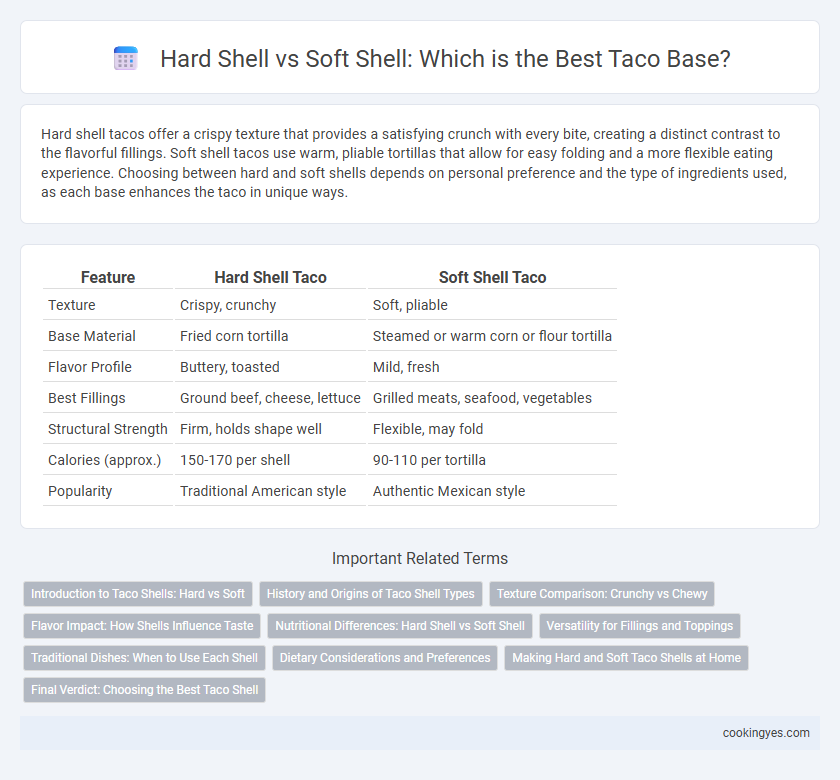Hard shell tacos offer a crispy texture that provides a satisfying crunch with every bite, creating a distinct contrast to the flavorful fillings. Soft shell tacos use warm, pliable tortillas that allow for easy folding and a more flexible eating experience. Choosing between hard and soft shells depends on personal preference and the type of ingredients used, as each base enhances the taco in unique ways.
Table of Comparison
| Feature | Hard Shell Taco | Soft Shell Taco |
|---|---|---|
| Texture | Crispy, crunchy | Soft, pliable |
| Base Material | Fried corn tortilla | Steamed or warm corn or flour tortilla |
| Flavor Profile | Buttery, toasted | Mild, fresh |
| Best Fillings | Ground beef, cheese, lettuce | Grilled meats, seafood, vegetables |
| Structural Strength | Firm, holds shape well | Flexible, may fold |
| Calories (approx.) | 150-170 per shell | 90-110 per tortilla |
| Popularity | Traditional American style | Authentic Mexican style |
Introduction to Taco Shells: Hard vs Soft
Hard shell tacos feature a crispy, fried corn tortilla that provides a crunchy texture and holds fillings firmly, making them ideal for hearty ingredients like ground beef and cheese. Soft shell tacos use fresh, pliable corn or flour tortillas that offer a tender bite and better flexibility, perfect for wrapping with delicate fillings such as grilled chicken or fish. Choosing between hard and soft shells depends on personal preference for texture and the type of taco ingredients used.
History and Origins of Taco Shell Types
Taco shells have roots in Mexican cuisine where soft corn tortillas date back to indigenous Mesoamerican civilizations, serving as the traditional base for tacos. Hard shell tacos emerged later in the United States during the 20th century, popularized by fast-food chains seeking a convenient, crispy alternative. The evolution of taco shells reflects cultural adaptation, where soft tortillas signify authentic Mexican heritage, while hard shells represent American innovation in taco preparation.
Texture Comparison: Crunchy vs Chewy
Hard shell tacos offer a distinctively crunchy texture that creates a satisfying contrast with the tender fillings, enhancing each bite with a crisp snap. Soft shell tacos provide a chewy, pliable base that wraps around ingredients smoothly, delivering a tender and cohesive mouthfeel. Texture preferences between crunchy and chewy greatly influence overall taco enjoyment and complement different flavor profiles.
Flavor Impact: How Shells Influence Taste
Hard shell tacos offer a crispy texture that enhances the boldness of seasoned fillings, providing a contrast that accentuates spices and savory ingredients. Soft shell tacos, made from flour or corn tortillas, absorb the flavors of the fillings, resulting in a more cohesive and mellow taste experience. Choosing between hard and soft shells significantly influences the overall flavor profile and mouthfeel of the taco, shaping how spices, textures, and sauces are perceived.
Nutritional Differences: Hard Shell vs Soft Shell
Hard shell tacos typically contain fewer calories and less fat due to their corn-based composition, but they often have higher sodium content compared to soft shells. Soft shell tacos, usually made from flour tortillas, provide more carbohydrates and fiber but can also have increased levels of saturated fat depending on preparation. Choosing between hard and soft shells depends on individual nutritional goals, such as calorie control, fiber intake, or sodium restrictions.
Versatility for Fillings and Toppings
Hard shell tacos offer a sturdy base that holds chunky fillings like seasoned ground beef, beans, and shredded cheese without becoming soggy, making them ideal for crisp textures and layered toppings. Soft shell tacos provide flexibility and softness, accommodating a diverse range of fillings such as grilled meats, fish, fresh vegetables, and creamy sauces, allowing for easy folding and customization. Choosing between hard and soft shells depends on the preferred texture and the type of fillings and toppings used to optimize the overall taco experience.
Traditional Dishes: When to Use Each Shell
Hard shell tacos, known for their crispy texture, are traditionally used in dishes like Tex-Mex-inspired ground beef tacos, providing a satisfying crunch that contrasts with fresh toppings. Soft shell tacos, typically made from corn or flour tortillas, are essential for authentic Mexican recipes such as carnitas or barbacoa, allowing the meat and sauces to meld seamlessly. Choosing the shell depends on the desired texture and authenticity, with soft shells favoring moist fillings and hard shells enhancing crunchy, assembled ingredients.
Dietary Considerations and Preferences
Hard shell tacos offer a crunchy texture and are typically lower in calories and fat compared to soft shells, making them a preferred choice for those managing calorie intake. Soft shell tacos, often made from corn or flour tortillas, provide a gluten-free option when using corn, suitable for individuals with gluten intolerance or celiac disease. Dietary preferences also influence selection: soft shells tend to be more pliable and easier to fill with various ingredients, while hard shells are favored for their crispiness and distinct flavor profile.
Making Hard and Soft Taco Shells at Home
Making hard taco shells at home involves shaping corn tortillas and baking them until crisp to achieve the signature crunch, while soft taco shells are typically warmed or lightly grilled to retain flexibility and softness. Using fresh masa harina and proper hydration ensures flavorful, pliable tortillas that can be transformed into either hard or soft shells depending on cooking method. Homemade taco shells allow control over ingredients, texture, and thickness, enhancing the overall taco experience.
Final Verdict: Choosing the Best Taco Shell
Hard shell tacos provide a satisfying crunch and hold fillings firmly, making them ideal for hearty ingredients like ground beef and vegetables. Soft shell tacos offer more flexibility and a tender bite, enhancing the flavors of delicate fillings such as grilled chicken or fish. The best taco shell depends on personal preference and the desired texture, with hard shells excelling in crunch and soft shells preferred for their pliability and comfort.
Hard Shell vs Soft Shell for taco base Infographic

 cookingyes.com
cookingyes.com